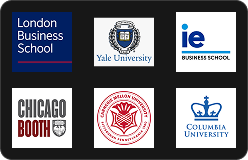
Top MEM Schools in USA: Why Everyone’s Talking About This Degree
What Is a MEM Degree and Why Is It So Popular?If you're a STEM graduate who wants to lead teams, manage projects, and s…
Table of Contents

A Master of Finance (MFin) is one of the most in-demand graduate degrees for students aiming to enter high-paying roles in finance, banking, investments, and fintech. These programs focus heavily on technical skills like financial modeling, data analytics, and risk management.
The USA is home to some of the best MFin programs in the world. What makes these schools stand out isn’t just their academic reputation, but also their strong ties to top employers, alumni networks, and access to global financial hubs like New York, Boston, Chicago, and San Francisco.
Whether you're targeting Wall Street, venture capital, private equity, or fintech startups, graduating from a top MFin program in the USA gives you a powerful edge in the job market.
Choosing to pursue a Master in Finance in the USA can unlock career opportunities around the world. The country offers access to some of the top-ranked finance programs, cutting-edge financial tools, and highly specialized coursework.
Here’s why students choose the best MFin programs in the USA:
Studying in cities like New York, Chicago, San Francisco, or Boston puts you close to major banks, investment firms, and financial tech startups. Many schools have partnerships with top companies, which means better internships and full-time job offers.
Graduates from top MFin programs in the USA earn starting salaries ranging from $75,000 to $115,000 or more. Some students from elite schools like MIT and Princeton secure offers above $130,000.
MFin programs are taught by experienced professors and industry experts. Students use Bloomberg terminals, Python/R for finance modeling, and case studies from real companies.
Most MFin programs in the US are STEM-designated, which means international students can stay in the country for up to 36 months after graduation without needing H-1B sponsorship right away.
A Master in Finance from a US university is respected worldwide. Whether you want to work in the US, Europe, Asia, or the Middle East, your degree will carry weight with top employers.
If you’re an international student, this section is especially for you. One of the key advantages of doing an MFin in the USA is access to STEM OPT extensions, which allow you to stay and work in the US for up to three years after graduation.
STEM stands for Science, Technology, Engineering, and Math. Many MS in Finance in USA programs are now STEM-designated because they include coursework in:
If staying in the US post-graduation is part of your goal, be sure to apply to STEM MFin programs in the USA.
One of the main reasons students pursue a Master in Finance in the USA is the strong return on investment. Graduates from top programs land roles at leading global firms in sectors like investment banking, asset management, consulting, private equity, and fintech.
Most top MFin programs in the USA report employment rates of 90–96% within 3–6 months of graduation. Many students even secure job offers before they finish the program.
Here’s a general salary range for recent graduates:
| School Tier | Average Starting Salary |
|---|---|
| Elite Programs (MIT, Princeton) | $110,000 – $130,000+ |
| Top 10 Programs | $95,000 – $115,000 |
| Public Universities (UIUC, Maryland, UC Irvine) | $75,000 – $95,000 |
MFin USA salary levels are among the highest globally for early-career finance professionals. And in high-cost markets like New York or San Francisco, total compensation can be significantly higher when bonuses are included.
Graduates from top MFin programs in the USA typically land roles such as:
Some of the most common recruiters include:
With the added advantage of STEM OPT, international students also have more flexibility and time to break into the US job market.

Choosing the right school means understanding how programs differ in cost, length, job outcomes, and academic focus. Here’s a side-by-side look at some of the top MFin programs in the USA:
| University | Tuition (USD) | Duration | Avg. Salary (After Grad) | Location |
|---|---|---|---|---|
| MIT Sloan | ~$88,000 | 12–18 months | $115,000+ | Cambridge, MA |
| Princeton University | ~$60,000 | 2 years | $110,000+ | Princeton, NJ |
| Columbia Business School | ~$83,000 | 16 months | $100,000+ | New York, NY |
| UC Berkeley (Haas) | ~$71,000 | 1 year | $95,000+ | Berkeley, CA |
| University of Chicago (Booth) | ~$75,000 | 10–15 months | $105,000+ | Chicago, IL |
| NYU Stern | ~$78,000 | 1 year | $100,000+ | New York, NY |
| UCLA Anderson | ~$67,000 | 13 months | $90,000+ | Los Angeles, CA |
| Boston College (Carroll) | ~$55,000 | 1 year | $85,000+ | Chestnut Hill, MA |
| Brandeis International Business School | ~$52,000 | 16–21 months | $80,000+ | Waltham, MA |
| Washington University (Olin) | ~$57,000 | 10–16 months | $90,000+ | St. Louis, MO |
Note: Tuition can vary based on program length, elective choices, and internship modules. Many schools offer scholarships and assistantships, especially for high-performing or international applicants.
These programs are consistently ranked among the best Master in Finance programs in the world due to their strong academic foundations, placement records, and employer reputation.
If you're aiming for a career in finance, both the MBA and MFin can get you there—but they’re built for different types of students and goals. Here’s how to decide which one suits you best.
If you're early in your career and want to jump straight into finance roles, the Master in Finance USA path is a faster, more targeted option.
If you're sure about a finance career—whether in investment banking, asset management, or quantitative finance—an MFin degree gives you a head start.
MFin programs are shorter and more affordable, making them ideal for students who want a high return on investment.
Both MBA and MFin programs in the USA can be STEM-designated, which qualifies international graduates for the 36-month OPT period. Always check each program's STEM status individually.
An MFin in the USA is often the best fit for early-career professionals who want a focused, affordable, and fast path into finance. MBA makes more sense for experienced professionals looking to expand beyond finance or lead larger business units.

The USA is home to some of the top MFin schools in the world, offering strong academic programs, global industry connections, and great job opportunities after graduation. Let’s take a closer look at some of the best options.
Overview
MIT’s Master of Finance (MFin) is one of the most respected programs in the world. It blends finance theory, math, and real-world skills. Students can finish it in 12 or 18 months.
Program Highlights
Career Outcomes
Graduates often land jobs at places like Goldman Sachs, BlackRock, and McKinsey. Many earn over $110,000 a year right after graduation.
Overview
Princeton offers a highly selective MFin program through its Bendheim Center for Finance. The focus is on strong math, economics, and analytical thinking.
Program Highlights
Career Outcomes
Graduates go on to careers in risk management, trading, and financial modeling at top global firms.
Overview
McCombs offers a 10-month MS in Finance that combines core business skills with hands-on learning. It’s a great option for students who want a short, intensive program.
Program Highlights
Career Outcomes
Graduates work in corporate finance, investment banking, and consulting. Job offers often come before graduation.
Overview
Fuqua doesn’t have a traditional MFin, but offers a Master of Quantitative Management that can be tailored toward finance. It’s great for students who want to focus on finance and analytics.
Program Highlights
Career Outcomes
Graduates go into finance roles that require strong data skills—like financial consulting, risk analysis, and portfolio management.
Overview
The Gies College of Business offers a flexible MS in Finance. It’s known for being affordable and offering strong returns.
Program Highlights
Career Outcomes
Students land jobs in investment banking, asset management, and corporate roles. Many also pursue CFA certifications alongside the degree.
Overview
Smith’s MFin program is practical and fast-paced. It’s strong in corporate finance, risk, and fintech.
Program Highlights
Career Outcomes
Grads work in private equity, banking, and analytics, especially in DC and New York.
Overview
Fordham’s MS in Finance offers strong global finance courses and a great location in New York City.
Program Highlights
Career Outcomes
Many students work in hedge funds, investment banks, and global corporations. Career support is hands-on.
Overview
BU’s Master in Mathematical Finance & Financial Technology (MSMFT) is built for students who want a mix of finance and tech.
Program Highlights
Career Outcomes
Graduates work in fintech, trading, and financial modeling. Recruiters come from top banks and consulting firms.
Overview
Ross offers a strong MFin-like experience through its Master of Accounting and Finance electives or dual-degree paths. It’s perfect for students looking for customizable options.
Program Highlights
Career Outcomes
Graduates land roles in equity research, asset management, and private banking, with competitive salaries.

The USA is home to many of the world’s top MFin schools, offering strong academics, expert faculty, and great career opportunities. From MIT and Princeton to Texas McCombs and Fordham, each program brings something unique—whether it’s advanced data skills, deep finance theory, or Wall Street access.
We explored the best options among the top 20 MFin schools in the USA, what makes them stand out, and how they prepare students for high-paying roles in finance. We also looked at key factors like curriculum, internships, career support, and tuition costs.
With so many options across the USA, it’s important to select a Master in Finance program that aligns with your personal, academic, and career goals. Here are the key factors to consider when evaluating the best MFin programs in the USA.
Not all MFin programs are the same. Some lean toward quantitative finance and analytics, while others focus on corporate finance, investment banking, or fintech.
Choose between one-year and two-year programs based on your timeline and work preferences.
Also, check whether the program is STEM-designated — crucial for international students who want up to 36 months of work authorization under OPT.
Some top universities in the USA for masters in finance are expensive, but they may also offer better job placement and higher starting salaries.
Studying in a major finance hub can open more doors.
Look for schools that offer:
A great MFin program in the USA not only teaches finance—it connects you to the people who will help shape your career.
